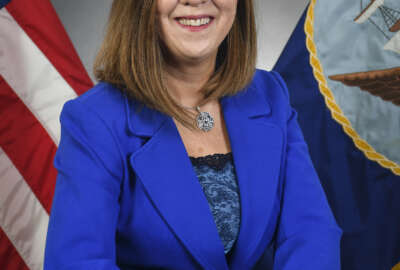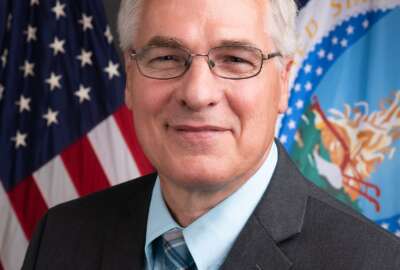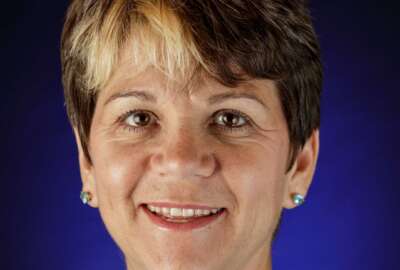She hasn’t been in space personally, but her work has helped NASA succeed
When NASA send people to Mars and or the moon, it's thanks to thousands of people who will never get there themselves. One of those people is Vanessa Wyche, who has...
Best listening experience is on Chrome, Firefox or Safari. Subscribe to Federal Drive’s daily audio interviews on Apple Podcasts or PodcastOne.
When NASA succeeds in sending people to Mars and returning them to the moon, it will be thanks to thousands of people who will never get there themselves. One of those people has had a 31-year career at NASA leading teams concerned with a variety of activities. Planning human space travel. Improving Space Station safety. Bringing commercial launch capabilities to NASA. For her career work, she’s a recent Presidential Rank Award recipient. The Federal Drive with Tom Temin spoke with the director of the Johnson Space Center, Vanessa Wyche.
Interview transcript:
Tom Temin: When NASA succeeds in sending people to Mars and returning them to the moon, it will be thanks to 1000s of people who never get there themselves. One of those people has had a 31 year career at NASA leading teams concerned with a variety of activities, planning, human space travel, improving Space Station safety, bringing commercial launch capabilities to NASA for her careers at work. She’s a recent presidential rank award recipient, the director of the Johnson Space Center, Vanessa white, she joins me now. Ms. Wyche, good to have you on.
Vanessa Wyche: Good morning. Glad to be on. Thank you.
Tom Temin: And congratulations on getting a Presidential Rank Award. And I want to get right into it, because you have some really interesting career highlights, including leading the team that looked at the whole issue of space exploration beyond the moon by human beings, because we know NASA has gotten to Mars, but not with people aboard, and tell us what that involved in what you did there.
Vanessa Wyche: Yes, well, Tom, I had the privilege of leading a directorate here at Johnson called the Exploration Integration and Science Directorate. And they’re leading the mission planners that look at human missions beyond what we’re doing in low Earth orbit. And so working with our sister centers and headquarters on identifying plans for going to Mars, but utilizing an understanding that we need to prove technologies and operations closer to home. So with the moon being 250,000 miles away, we can get there in about three days, versus going to Mars, which going there and coming back is a three year round trip. So we’ve been planning and working and laying out human missions, then working with our mission directorate up at NASA headquarters and agreeing that we needed to work with the international community as well as the commercial providers to come up with the plan. So laying that out, what we put together was a global exploration roadmap. And the plans that we have today are built along those plans, as well. So we are going with Artemis, as you may know, that’s our current moon plan, where we will go to the moon. We’ll have a platform that’s being managed out of the Johnson Space Center called Gateway. And that platform will allow us to have human landers, those landing systems will attach to the Gateway, and those landing systems, will go to the moon. Then after we have tested out some technologies and proven operations and set up a lunar base, we will have the ability to do testing and then move forward to Mars.
Tom Temin: Well, let me ask you this. I mean, from everything I’ve read, and the people I’ve interviewed at NASA, there are lots of brilliant people there in the science and engineering area. I imagine those conversations can get tough, you know, and maybe a little headstrong, and how do you keep the emotion out of something that is so consequential so that you can arrive at a goal that everyone can live with, and still speak to each other afterwards?
Vanessa Wyche: So Tom, we are an organization, as you just said, of engineers and scientists, and we believe in data, we believe in facts. So what we do is that we lay and we present that information out. And we challenge one another to make sure that we come up with the best solution. That the emotion is taken out of it by sticking to what is proven and what we know we can prove going forward.
Tom Temin: And you as a high level administrator also have some pretty serious engineering chops in your own background, correct?
Vanessa Wyche: Yes, I do have an undergraduate degree in engineering as well as a master’s degree in bio-engineering. And I began my career here as a project engineer building flight hardware, and flying that on the space shuttle, working my way up through management to managing shuttle missions that actually built the International Space Station, and being a part of human spaceflight for many years. So I do have a lot of experience.
Tom Temin: And I’m thinking that must be a high that not a lot of people get when you watch these instruments actually take off and go places that everyone around you might be cheering and screaming and you have some inner knowledge that they don’t.
Vanessa Wyche: It is a wonderful feeling. When you see your experiment, and you see your astronauts, you see the space station coming together, and knowing all that it took to make that happen, but then just the satisfaction of just marveling in what we can achieve as human beings.
Tom Temin: We’re speaking with Vanessa Wyche. She’s director of NASA’s Johnson Space Center, and recipient of one of this year’s Presidential Rank Awards. And let me ask you about the incident that you had some help to improve safety at the International Space Station after, it’s not exactly as well known as Apollo 13. But there was a serious mishap that could have resulted in loss of life.
Vanessa Wyche: Yes, we had astronauts that were out doing what we call an extra vehicular activity, are in spacewalk outside of the International Space Station. And because of a malfunction there was water that got into the helmet. And in zero gravity, microgravity, that water can move up and into as much was coming in, potentially cause someone to not be able to get air, you drown. However, in this instance, we were able to quickly respond operationally, and get the astronaut back inside and to save him from that situation. So following that incident, we had a team of investigators looking at what caused it. Was it from a malfunction with the hardware system itself? Was it an operational error? We determined what the issue was, and it was with the hardware itself. We came up with a workaround that we now have in place. And so now when the astronauts go back out, there’s not an issue, we’ve solved it. However, we know that the hardware that we’re currently flying, we have been flying that same technology, but upgrades to it since the 1980s. And so we recently very just so super excited years of trying and pushing towards getting funding myself as director of the previous organization, EISD, expiration, integration to science, working with our headquarters team, with our stakeholders to get funding to now build a new suit. So we will have a new exploration suit that we will be testing out on the International Space Station and using for our upcoming Artemis missions.
Tom Temin: And we’ve been talking about a lot of activities that have been NASA’s own: the construction of the early space vehicles and the design of spacesuits and this kind of thing. Of course, in recent years, commercial technology, and commercial operations, really, have come deeply into what NASA is doing. And how has that been for someone whose career is NASA and surrounded by many career people at NASA, when you see industry starting to do, at NASA’s choice, what had been done earlier by NASA itself? How does that change things?
Vanessa Wyche: It’s a great benefit to us. Because as the commercial industry is able to take on and do more things, then we can focus our engineers and scientists on proving other technologies. So we’re very fortunate to currently have the Commercial Crew Program, where we have one company that is currently launching our astronauts from Florida. And we will have another one that will be coming online very soon. But that ability for us to have our astronauts to be able to launch again from Florida is a big deal. We’re very thankful for that. Then at the same time, it allows us to focus on other things like the deep space exploration that I talked about.
Tom Temin: And in 31 years at NASA as a career official in the last five or six years as a senior executive, you’ve seen administrations come and go, you’ve seen administrators come and go. You’ve seen priorities come and go and budgetary vicissitudes, come and go. How do you sustain your vision and your willingness to keep at it, when sometimes the situation surrounding a given center is just constantly in flux.
Vanessa Wyche: So I think it’s because of our desire to explore as humans, and to stay focused on the bigger picture of human exploration for my center. And we’ve been fortunate, as I mentioned, there have been times when we’ve had push and pulls between moon or Mars, but to finally come up with a plan that demonstrates that we can do both, that we can explore the moon for the benefit of then exploring Mars that will then allow us to go further into the universe.
Tom Temin: And what is your view of the up and coming workforce? I mean, you are still engaged with engineering colleges and universities, you’re on boards and panels connected to them. And there’s a lot going on in higher education that may be not so positive for the future workforce. But from the STEM side, what does it look like to you at this point?
Vanessa Wyche: Well, I’m just so very thrilled because now at the universities, because of the push at NASA and so many other organizations of making people aware of STEM and STEM careers. We have such diversity coming out of our colleges, so many more women, so many people of color. And so that is going to be very important for us, as our agency brings those folks in and bring them into working as a part of our NASA team.
Tom Temin: And sounds like you would choose a federal career again, if you had an array before you.
Vanessa Wyche: I’ve had a wonderful career. Tom, I would. I can just tell you that I began my career with the Food and Drug Administration as a medical device evaluator and loved it. Great job, the opportunity that I’ve had at NASA, the career that I’ve had here, every day I get to come to work and do what I love to do.
Tom Temin: Is it better to be in Houston than in Washington?
Vanessa Wyche: From my point of view, it’s a toss up. But I would just tell you, I love it here. I love being able to come to work every day and know that our astronauts are safe and sound on board the International Space Station. They have been for 21 years, and I have the opportunity to help them make sure that that continues to happen.
Tom Temin: Vanessa Wyche is director of NASA’s Johnson Space Center, and a recipient of one of this year’s Presidential Rank Awards. Thanks so much for joining me.
Vanessa Wyche: Thank you so very much.
Copyright © 2025 Federal News Network. All rights reserved. This website is not intended for users located within the European Economic Area.
Tom Temin is host of the Federal Drive and has been providing insight on federal technology and management issues for more than 30 years.
Follow @tteminWFED






